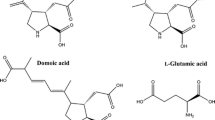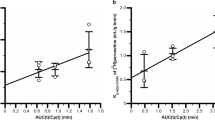Abstract
In the present work, the transport mechanism of a capsaicin derivative, DA-5018, through blood-brain barrier (BBB) has been investigated to evaluate the feasibility of potential drug development. The result of pharmacokinetic parameters obtained from the intravenous injection of plasma volume marker, [3H]RSA and [14C]DA-5018, indicated that both AUC, area under the plasma concentration curve and VD, volume of distribution in brain of [3H]RSA agreed with those reported (1620±10 percentage injected dose minute per milliliter (%IDmin/ml) and 12.0±0.1 μl/g, respectively). Elimination half-life and AUC of [14C]DA-5018 is corrected by the HPLC analysis, 19.6±1.2 min and 7.69±0.85% IDmin/ml, respectively. The metabolic rate of [14C] DA-5018 was very rapid. The blood-brain barrier permeability surface area (PS) product of [14C]DA-5018 was calculated to be 0.24±0.05 μl/min/g. The result of internal carotid artery perfusion and capillary depletion suggested that [14C]DA-5018 pass through BBB with the time increasingly. Investigation of transport mechanism of [14C]DA-5018 using agonist and antagonist suggested that vanilloid (capsaicin) receptor did not exist in the BBB, and nutrient carrier system in the BBB has no effect on the transport of DA-5018. In conclusion, despite the fact that penetration of DA-5018 through BBB is significant, the intact drug found in the brain tissue is small because of a rapid metabolism. Therefore, for the central analgesic effect of DA-5018, the method to increase the metabolic stability in plasma and the brain permeability should be considered.
Similar content being viewed by others
References Cited
Lundberg, J. M., and Saria, A., Polypeptide-containing neurons in airway smooth muscle.Annu. Rev. Physiol. 49, 557–572 (1987).
Hokfelt, T., Johansson, O., Ljungdahl, A., and Lundberg, J. M., Peptidergic neurons.Nature 284, 515–521 (1980).
Saria, A., Martling, C., and Yan, Z., Release of multiple tachykinins from capsaicin-sensitive sensory nerves in the lung by bradykinin, histamine, dimethylphenyl piperazinium and vagal nerve stimulation.Am. Rev. Respir., 41, 167–172 (1988).
LaHann, T. R., Antinociceptive actions of capsaicin in rodents.Proc. West. Pharm. Soc. 26, 145–149 (1983).
Holzer, P., Capsaicin; Cellular targets, mechanisms of action and selectivity for thin sensory neurons.Pharmacol. Rev., 43, 143–201 (1991).
Park, N. S., Ha, D. C., Choi, J. K., and Kim, H. S., Phenylacetamide derivatives and pharmaceutical compositions thereof.U. S. Patent No. 5, 242, 944 (1993).
Bernstein, J. E., Korman, N. J., and Bickers, D. R., Topical capsaicin treatment of chronic postherpetic neuralgia.J. Am. Acad. Dermatol. 21, 265–270 (1991).
Ross, D. R., and Varipapa, R. J., Treatment of painful diabetic neuropathy with topical capsaicin.N. Eng. J. Med. 321, 474–475 (1989).
McCarthy, G. W., and McCarthy, D. J., Effect of topical capsaicin in the therapy of painful osteoarthritis of the hands.J. Rheumatol., 19 604–607 (1992).
Lee, B., Kim, J. H., Park, N. S., and Kong, J. Y., KR-25018; A Novel, orally active analgesic with nonnarcotic properties.Arch. Pharm. Res. 17: 304–308 (1994).
Reid, J., and McCulloch, J., Capsaicin and blood-brain barrier permeability.Neurosci. Lett. 81, 165–170 (1987).
Szallasi, A., and Goso, C., Competitive inhibition by capsazepine of [3H]Resiniferatoxin binding to central (spinal cord and dorsal root ganglion) and peripheral urinary bladder and airways) vanilloid (capsaicin) receptors in the rat.J Pharmacol. Exp. Ther. 267, 728–733 (1993).
Gibaldi, M., and Perrier, D.,Pharmacokinetics, Marcel Dekker, Inc. New York, 1982.
Shim, H. J., Lee, J. J., Lee, S. D. and Kim, W. B., Determination of a new non-narcotic analgesic DA-5018, in plasma, urine and bile by HPLC.J. Chromatogr. B. Biomed. Appl. 689, 422–426 (1997).
Takasato, Y., Rapoport, S. I., and Smith, Q. R., An in situ brain perfusion technique to study cerebrovascular transport in the rat.Am. J. Physiol. 247, H484–493 (1984).
Triguero, D., Buciak, J. B., and Pardridge, W. M., Capillary depletion method for quantifying blood-brain barrier transport of circulating peptides and plasma protein.J. Neurochem. 54, 1883–1888 (1990).
Pardridge, W. M., Kang, Y. S., and Buciak, J. L., Transport of human recombinant brain-derived neurotrophic factor (BNDF) through the rat blood-brain barrier in vivo using vector-mediated peptide drug delivery.Pharm. Res. 11, 738–746 (1994).
Broadwell, R. D., Salcman, M., and Kaplan, R. S., Morphologic effect of dimethyl sulfoxide on the blood-brain barrier.Science 21, 164–166 (1982).
W. Michael Scheld Drug delivery to the central nervous system; General principles and relevance to therapy for infections of the central nervous system.Rev. Infec. Disea. 11, S1669-S1690 (1989).
Samii, A., Bickel, U., Stroth, U., and Pardridge, W. M., Blood-brain barrier transport of neuropeptides: analysis with a metabolically stable dermorphin analogue.Am. J. Physiol. 267, E124-E131 (1994).
Nutt, J. G., Hammerstad, J. P., and Woodward, W. R., The “on-off” phenomenon in Parkinson’s disease. Relation to levodopa absorption and transport.N. Engl. J. Med. 310, 483–488 (1984).
Sved, A. F., Goldberg, I. M., and Fernstrom, J. D., Dietary protein intake influences the antihypertensive potency of methyldopa in spontaneously hypertensive rats.J. Pharmacol. Exp. Ther. 214, 147–151 (1980).
Pardridge, W. M., Brain metabolism; a perspective from the blood-brain barrier.Physiol. Rev. 63, 1481–1535 (1983).
Betz, A. L., Csejtey, J., and Goldstein, G. W., Hexose transport and phosphorylation by capillaries isolated from rat brain.Am. J. Physiol. 236, C96–102 (1979).
Brust, P., Changes in regional blood-brain transfer of L-leucine elicited by arginine-vasopressin.J. Neurochem. 46, 534–541 (1986).
Goldstein, G. W, and Betz, A. L., The blood-brain barrier.Sci. Am. 255, 74–83 (1986).
Wu, D., Kang, Y. S., Bickel, U., and Pardridge, W. M., Blood-brain barrier permeability to morphine-6-glucuronide is markedly reduced compared with morphine.Drug Metab. Dispos. 25, 768–771 (1991).
Author information
Authors and Affiliations
Rights and permissions
About this article
Cite this article
Kang, YS., Kim, JM. Permeability of a capsaicin derivative, [14C]DA-5018 to blood-brain barrier corrected with HPLC method. Arch Pharm Res 22, 165–172 (1999). https://doi.org/10.1007/BF02976541
Received:
Issue Date:
DOI: https://doi.org/10.1007/BF02976541




